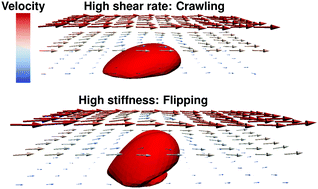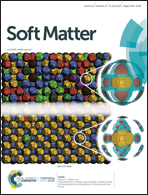State diagram for wall adhesion of red blood cells in shear flow: from crawling to flipping†
Abstract
Red blood cells in shear flow show a variety of different shapes due to the complex interplay between hydrodynamics and membrane elasticity. Malaria-infected red blood cells become generally adhesive and less deformable. Adhesion to a substrate leads to a reduction in shape variability and to a flipping motion of the non-spherical shapes during the mid-stage of infection. Here, we present a complete state diagram for wall adhesion of red blood cells in shear flow obtained by simulations, using a particle-based mesoscale hydrodynamics approach, multiparticle collision dynamics. We find that cell flipping at a substrate is replaced by crawling beyond a critical shear rate, which increases with both membrane stiffness and viscosity contrast between the cytosol and suspending medium. This change in cell dynamics resembles the transition between tumbling and tank-treading for red blood cells in free shear flow. In the context of malaria infections, the flipping–crawling transition would strongly increase the adhesive interactions with the vascular endothelium, but might be suppressed by the combined effect of increased elasticity and viscosity contrast.



 Please wait while we load your content...
Please wait while we load your content...